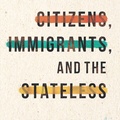Although certainly not an American labor historian per se, I am profoundly abashed that, notwithstanding my having been researching, writing, and teaching about the unjust Japanese American World War II detention for five decades, I never until now paid more than fleeting attention to the predominant focus of the invaluable book under review here by Stephanie Hinnershitz: “the design and implementation of Japanese American incarceration and the centrality of labor to both of these undertakings” (p. 22).
In addition to Hinnershitz being the well-deserved recipient of the 2022 Philip Taft Labor History Award for “Japanese American Incarceration,” she should be roundly lauded by practitioners and students alike of Japanese American history for penning the first study that, in the author’s own words, categorizes the experiences of Nikkei laborers under Executive Order 9066 “as coerced prison work” (p. 4).
In this same vein, the book’s publisher, the University Press of Pennsylvania, draws upon the opinions of two giants in the field of Asian American studies, Erika Lee and John Howard, to highlight Hinnershitz’s signal achievement. Whereas the former commends her scholarship for exposing “a deeper infringement of Japanese Americans’ rights than had been previously understood and compels us to revise how we teach this tragic chapter in American history,” the latter makes the claim that Hinnershitz’s “bold interpretation” (rooted in rigorous archival research) “forces a thoroughgoing rethink of the American carceral state.”
Japanese American Incarceration consists of five chapters which, taken together, present a tripartite scenario:
- (1) that the utilization (i.e., exploitation) of Japanese American labor in the so-called “assembly centers” and “relocation centers” (i.e., concentration camps) was an important goal guiding the U.S. government’s policy of enforced mass incarceration;
- (2) that the labor extracted from Japanese American inmates was crucial to their assorted mobilizations of resistance to what they deemed as darkly oppressive treatment; and
- (3) that the state-coerced wartime work of Nikkei incarcerees was consistent with the tradition of American prison labor.
Hinnershitz’s opening two chapters revolve around how the decisive consideration by the U.S. government to employ Japanese American labor in the camps figured prominently in the decisions about their locations (i.e. replete with neighboring agricultural land contributing to site self-sufficiency), augmented by “convenient” fringe benefits (such as having inmates being granted periodical releases so as to provide inexpensive farm labor employment for privately owned nearby properties).
Chapters three and four are case studies set at one assembly center in California, Santa Anita, and two reception centers/relocation centers, Manzanar in California and Poston in Arizona, all of which witnessed noteworthy manifestations of inmate insurrection.
As for the fifth chapter, it explores the entangling of labor and resettlement, whereby Japanese Americans could be released from the camps to secure jobs outside of the West Coast exclusion zones as “parolees” in jobs within a “work-release” program.
Overall, Japanese American Incarceration is both an amply researched and a well-written monograph. Its flaws for the most part are comparatively minor ones, such as the misspelling of the names of two prominent Japanese Americans, Sue Kunitomi Embrey (p. 275) and Minoru Yasui (pp. 249, 309).
A more serious error is Hinnershitz’s flagrant mischaracterization of Manzanar’s second project director Roy Nash, charging him with being “more focused on maintaining good relations with the local townspeople than … the challenges of running Manzanar and implementing better living, working, and self-governing policies” (p. 131), when the reverse situation was in reality the actual case.
JAPANESE AMERICAN INCARCERATION: The Camps and Coerced Labor During World War II
By Stephanie Hinnershitz
(Philadelphia: University of Pennsylvania Press, 2021, 309 pp., $39.95, hardcover)
*This article was originally published in Nichi Bei News on July 20, 2023.
© 2023 Arthur A. Hansen, Nichi Bei News








